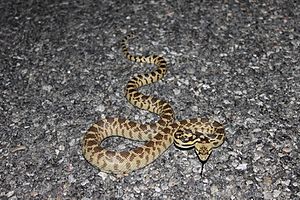Pituophis catenifer deserticola facts for kids
Quick facts for kids Pituophis catenifer deserticola |
|
|---|---|
 |
|
| Scientific classification |
|
| Kingdom: | Animalia |
| Phylum: | Chordata |
| Class: | Reptilia |
| Order: | Squamata |
| Suborder: | Serpentes |
| Family: | Colubridae |
| Genus: | Pituophis |
| Species: | |
| Subspecies: |
P. c. deserticola
|
| Trinomial name | |
| Pituophis catenifer deserticola Stejneger, 1893
|
|
The Great Basin gopher snake (Pituophis catenifer deserticola) is also known as the bull snake. It is a type of snake that is not venomous. This snake belongs to a group called colubrids, which are a large family of snakes. It lives only in the western parts of the United States and nearby southwestern Canada. This means it is endemic to these areas.
Contents
Where Does the Great Basin Gopher Snake Live?
This snake makes its home in many places across the western United States. You can find it in states like Arizona, California, Colorado, Idaho, Nevada, New Mexico, Oregon, Utah, Washington, and Wyoming. In Canada, it lives in British Columbia.
The Great Basin gopher snake likes different kinds of environments. It can be found in grasslands, woodlands, and even deserts. It also lives in areas with coastal sage scrub, on farmland, and near rivers or streams.
What Does the Great Basin Gopher Snake Look Like?
Adult Great Basin gopher snakes are usually about 4.5 feet (137 cm) long. The longest one ever recorded was 5.75 feet (175 cm) long.
These snakes have dark brown or black spots on their backs. These spots are connected by thin lines along the front part of their body. They usually have a dark stripe on each side of their neck. This stripe is surrounded by lighter colors. Towards the back of the snake, this stripe breaks up into dashes or small spots. Their body scales feel rough because they have a ridge, which is called "keeled." Their head has a pointed shape. The snake's belly is a creamy color with small, dark, uneven blotches.
How Long Do They Live?
There are different ideas about how long these snakes live. Some reports say they live about 7 years. Others suggest they live 12 to 15 years. The oldest Great Basin gopher snake ever recorded lived for 33 years and 10 months!
How Do Great Basin Gopher Snakes Behave?
The Great Basin gopher snake is very good at climbing trees, swimming in water, and digging burrows in the ground. People often see these snakes when they are hiking or driving. This is especially true in spring when male snakes are looking for a mate. Baby snakes, called hatchlings, are often seen in late August and September. This is when they come out of their eggs.
Like most wild animals, Great Basin gopher snakes are usually not dangerous. They only defend themselves if they feel threatened. When a gopher snake feels scared, it will lift and puff up its body. It will also flatten its head into a triangle shape. Then, it will make loud hissing noises. It will also quickly shake its tail. This shaking sounds a lot like a rattlesnake's rattle. However, it's important to remember that the Great Basin gopher snake is not venomous. It cannot hurt you with venom.
What Do Great Basin Gopher Snakes Eat?
The Great Basin gopher snake is a carnivore. This means it eats other animals. Its diet includes many different creatures. It eats insects, lizards, and birds. It also eats bird eggs. Small mammals are a very common food for them. This includes animals like pocket gophers.
Reproduction and Life Cycle
Great Basin gopher snakes lay eggs. They usually lay their eggs between June and August. After the adult snakes mate in the spring, the female snake will lay her eggs. She usually lays between 3 and 24 eggs. On average, a female lays about 7 eggs.
It takes about 2 to 2.5 months for the eggs to hatch. When the young snakes come out of their eggs, they are usually about 12 to 18 inches (30 to 46 cm) long.
Images for kids
- Stejneger, L. 1893. Annotated List of the Reptiles and Batrachians Collected by the Death Valley Expedition in 1891, with Descriptions of New Species. North American Fauna (7): 159-228. ("Pituophis catenifer deserticola, subsp. nov.", pp. 206–208.)


